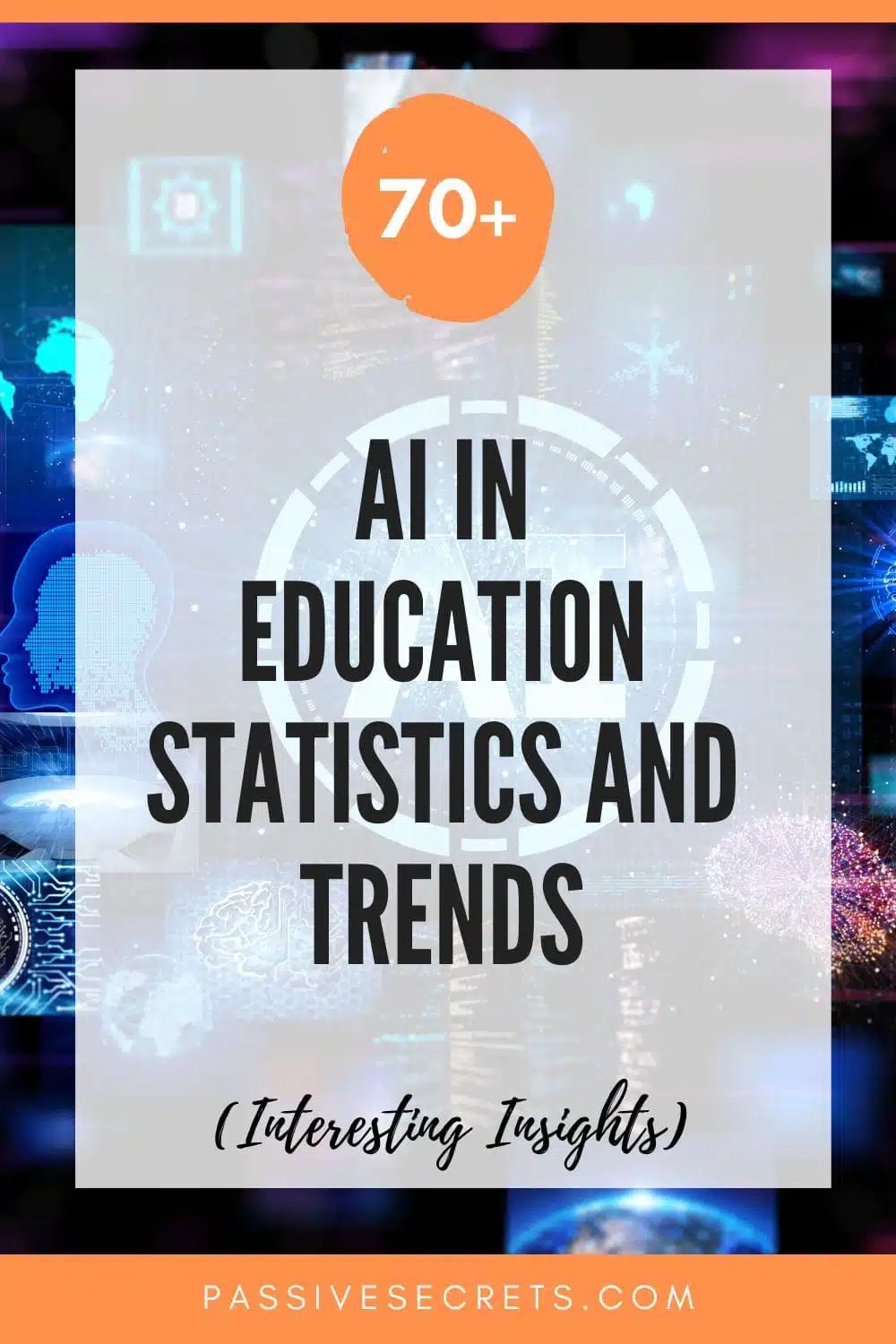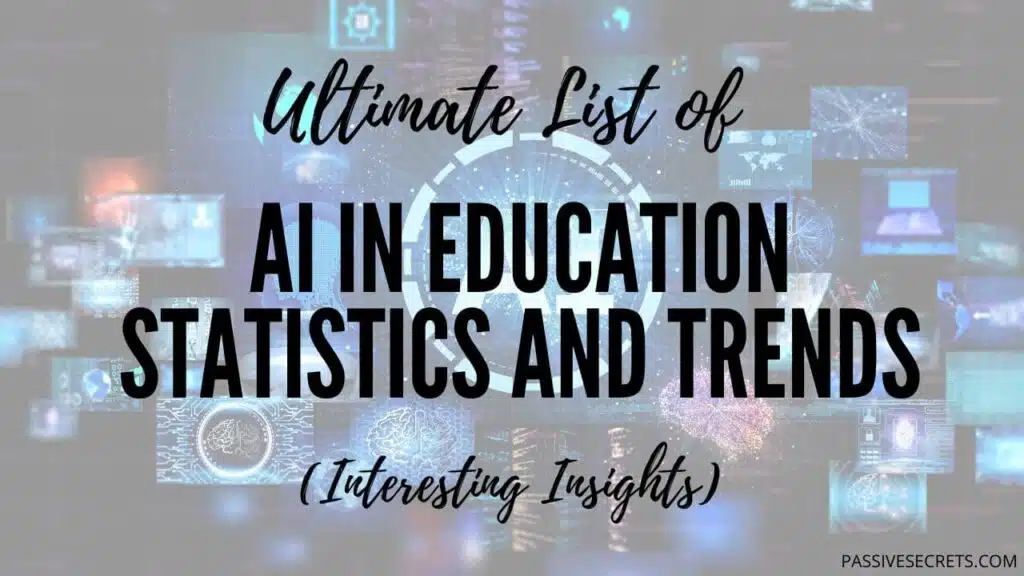
AI in education is no longer a futuristic concept; it’s here. Artificial intelligence is evolving our education system – transforming classrooms, curriculums, and the way students learn across the globe.
From personalized learning experiences to automated grading systems, AI is reshaping education as we know it. The latest AI in Education Statistics reveals a market growth from $5.18 billion in 2024 to a staggering $112.3 billion by 2034, showing the immense impact of AI in this sector.
These figures highlight a significant shift driven by cutting-edge technology and innovative teaching methods.
In this article, we’ll explore the most compelling AI in education statistics and trends that showcase how artificial intelligence is revolutionizing education.
Key AI In Education Statistics (Editor’s Pick)
- The global AI education technology market was valued at $3.925 billion in 2023.
- 59% of teachers have a positive impression of AI chatbots.
- 77% of students still rely on search engines as their primary source of information.
- Both students (47%) and teachers (48%) report that AI technologies have had a beneficial impact on the student learning experience.
- 44% of educators who have used generative AI said it has reduced their workload and made their jobs easier.
- 44% of educators say using generative AI in class reports eased their workload, while 38% remain undecided about its impact.
- 15% of teachers aged 18-34 have used GenAI, compared to 9% of those aged 45-54.
- High school teachers believe AI’s biggest impact on students is increased confidence (58%), while college professors say it helps students learn new concepts faster (49%).
- Almost 20% of teachers interviewed stated that ChatGPT had a detrimental effect, a rise from 7% the year before.
- 72% of educators cited the potential for increased plagiarism and cheating as their biggest concern regarding generative AI.
- 93% of teachers and 79% of students believe that regulations should be established to control the use of text-generating AI in education.
- 72% of students and 81% of teachers express concern about the impact of AI on the future of learning.
Global AI in Education Market
1. The global market for AI in education is expected to grow from USD 5.18 billion in 2024 to approximately USD 112.30 billion by 2034, representing a CAGR of 36.02% over the decade. (source)
2. The AI in the education market in North America was valued at USD 1.45 billion in 2023. (source)
3. The U.S. AI in the education market, valued at USD 1.09 billion in 2023, is projected to reach USD 32.64 billion by 2034, growing at a CAGR of 36.21%. (source)
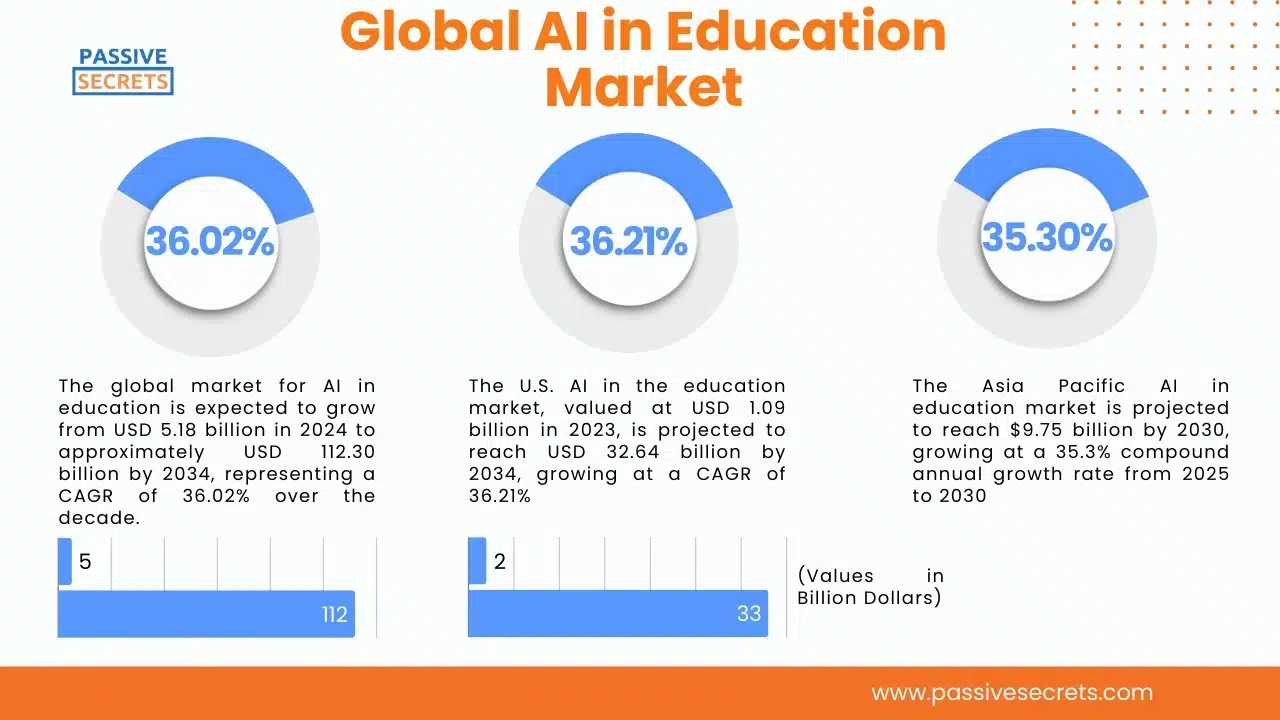
4. The Asia Pacific AI in education market is projected to reach $9.75 billion by 2030, growing at a 35.3% compound annual growth rate from 2025 to 2030. (source)
5. The global AI education technology market was valued at $3.925 billion in 2023. The Asia-Pacific region accounted for 23% of global revenue ($902.8 million) and is expected to grow at a 49.5% CAGR from 2023 to 2030. (source)
AI Adoption in Education
6. A 2024 global student survey revealed that 86% of respondents use AI tools for schoolwork, with nearly a quarter (24%) utilizing them daily. (source)
7. 59% of teachers have a positive impression of AI chatbots. (source)
8. According to a survey, K-12 students reported that they most frequently used AI chatbots for writing essays and completing assignments (56%), followed by studying for tests and quizzes (52%). (source)
9. A higher percentage of teachers use these technologies compared to students (65% vs. 61%), and teachers also tend to have a more favorable view of them. (source)
10. Half of the teachers (50%) express excitement or optimism about AI in education, compared to 39% of students. (source)
11. Students were more likely to have a neutral stance on AI’s role in education, with 20% expressing neutrality, compared to just 10% of teachers. (source)
12. The most common AI use cases among students are conducting research (44%), summarizing or synthesizing information (38%), and creating study guides or materials (33%). (source)
13. Students who study 3 hours or more per night are more likely to report using ChatGPT or similar AI technologies, with 72% indicating usage compared to 61% of those who study less. (source)
14. Data on the use of GenAI in education shows that between 14% and 67% of students have used GenAI for schoolwork and studies. (source)
15. Currently, 42% of primary and secondary teachers have used GenAI to assist with schoolwork. (source)
16. 14% of secondary school teachers have used GenAI, compared to 9% of primary school teachers, while 23% of college educators have used it. (source)
17. 18% of male teachers have used GenAI, compared to 9% of female teachers. (source)
18. 74% of online 16–24-year-olds in the UK have used a GenAI tool. (source)
19. Overall, two-thirds of U.S. teens are aware of ChatGPT, with 23% having heard a lot about it and 44% having heard a little. Around 32% say they haven’t heard anything about it. (source)
20. A third of surveyed educators reported using AI in classrooms to create assessments, develop lesson plans, generate instructional content, and assist with grading. (source)
21. 62% of students have used AI at least once or twice. (source)
22. 68% of educators have used AI at least once or twice. (source)
23. Students who use AI technology for school primarily use it for research (46%), summarizing or synthesizing information (38%), and generating study guides or materials (31%). (source)
24. Teacher comfort with AI in the classroom increased significantly from 2.9 to 5.6 (out of 10) in just one year. (source)
25. Only 8% of teachers reported trying AI at their school administration’s request, highlighting the grassroots nature of its adoption. (source)
26. Teachers rate their experience with AI at 3.3 out of 5, showing cautious optimism. Most use AI occasionally, with 73% employing it only a few times a year or monthly. (source)
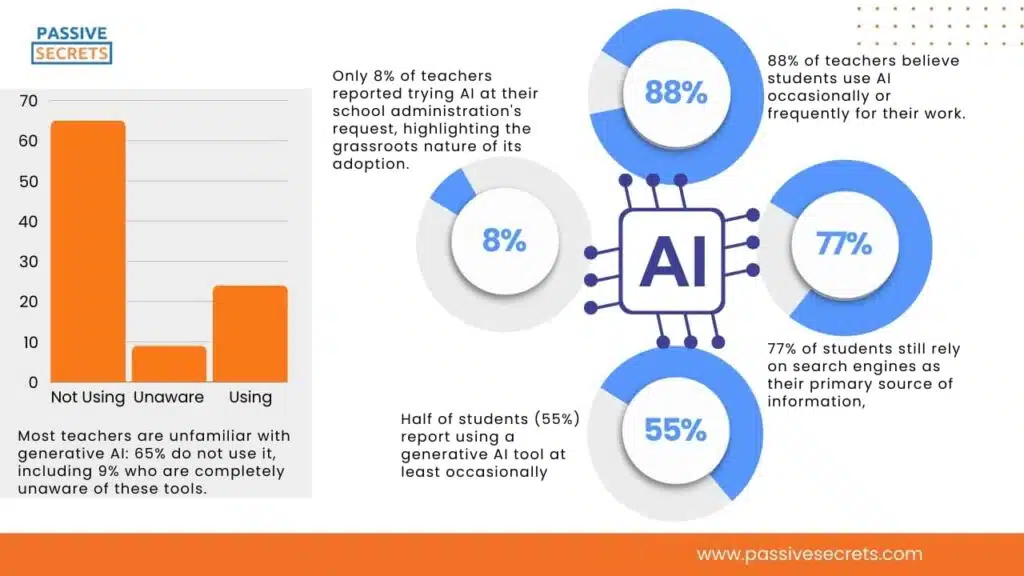
27. Half of students (55%) report using a generative AI tool at least occasionally, while 88% of teachers believe students use AI occasionally or frequently for their work. (source)
28. 77% of students still rely on search engines as their primary source of information, while only 2% cite AI as their “first source of documentation.” (source)
29. Most teachers are unfamiliar with generative AI: 65% do not use it, including 9% who are completely unaware of these tools. (source)
Benefits and Impacts of AI in Education
30. Teachers reported using AI for various purposes, including generating class ideas (37%), creating lesson plans and preparing teaching materials (32%), designing student worksheets or examples (32%), and developing quizzes or tests (31%). (source)
31. Both students (47%) and teachers (48%) report that AI technologies have had a beneficial impact on the student learning experience. (source)
32. When asked about the impact of AI technologies on their schoolwork, students reported that 73% strongly or somewhat agree that these tools help them better understand the material, while 67% feel they enable them to study more quickly and efficiently. (source)
33. A Forbes Advisor survey found that 55% of U.S. educators believed AI improved educational outcomes, with 60% of the 500 educators surveyed using AI tools in their classrooms. (source)
34. A new survey on K–12 educators’ views of generative AI found that 90% of respondents believe the technology could make education more accessible for students requiring personalized learning. (source)
35. 44% of educators who have used generative AI said it has reduced their workload and made their jobs easier. (source)
36. AI can enhance productivity in tasks such as lesson planning and curriculum development, which account for 45% of teachers’ duties. (source)
37. Students are more likely than teachers to believe that AI creates a more equitable education system, with 41% of students compared to 33% of teachers. (source)
38. Students who study three or more hours a night during the school year are more likely than others to say AI technologies have positively affected their efficiency (62%), learning support (60%), and creativity and critical thinking (53%). (source)
39. 51% of students use content-generating tools to enhance their understanding of certain topics. (source)
40. Only 43% of students use AI as a “writer,” with 28% of them reformulating AI-generated texts before including them in their work. (source)
41. AI is primarily seen as a “writing assistant” to improve syntax and reformulate text. 75% of students and 67% of teachers consider this use acceptable. (source)
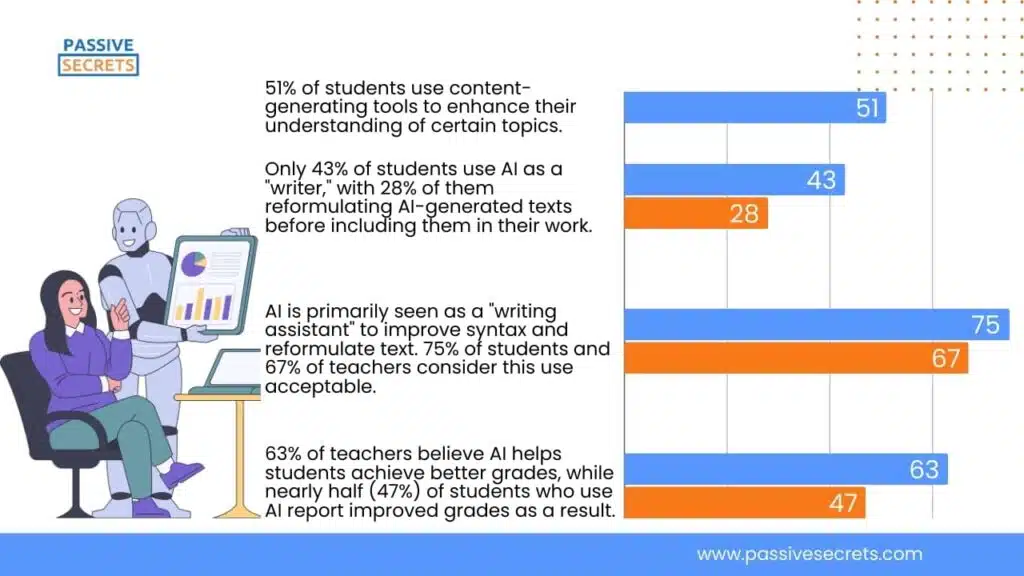
42. 63% of teachers believe AI helps students achieve better grades, while nearly half (47%) of students who use AI report improved grades as a result. (source)
43. Educators who’ve used generative AI in class report mixed results: 44% say it’s eased their workload, while 38% remain undecided about its impact. (source)
AI in Education by Sector
44. Parental support for AI in education is notably higher among Black (57%) and Hispanic (55%) parents. (source)
45. 15% of teachers aged 18-34 have used GenAI, compared to 9% of those aged 45-54. (source)
46. Secondary school educators were more likely than primary school teachers to have used GenAI for assessments, with 18% using it for formative assessments compared to 6%, and 16% using it for summative assessments compared to 3%. (source)
47. Around 24% of 11th and 12th graders who are familiar with ChatGPT have used it for schoolwork, compared to 17% of 9th and 10th graders and 12% of 7th and 8th graders. (source)
48. 82% of college students have used AI technologies, compared to 58% of high school students. Additionally, student adoption of AI is nearly on par with teachers, at 67% versus 66%. (source)
49. 48% of high school students are unsure if they will use AI technologies to prepare for college applications or standardized tests like the SATs and ACTs, while only 7% have already done so. (source)
50. According to a survey, high school teachers are more likely to be approached by students with permission-based AI questions (67% vs. 52%), while college teachers are more likely to receive questions about proper use cases (59% vs. 40%). (source)
51. A greater percentage of college students report that their institutions have established a code of conduct for AI use compared to high school students (41% vs. 18%). (source)
52. College students report greater positive impacts of AI on efficiency (63% vs. 53%), learning support (59% vs. 52%), and access to personalized materials (52% vs. 49%) compared to high school students. (source)
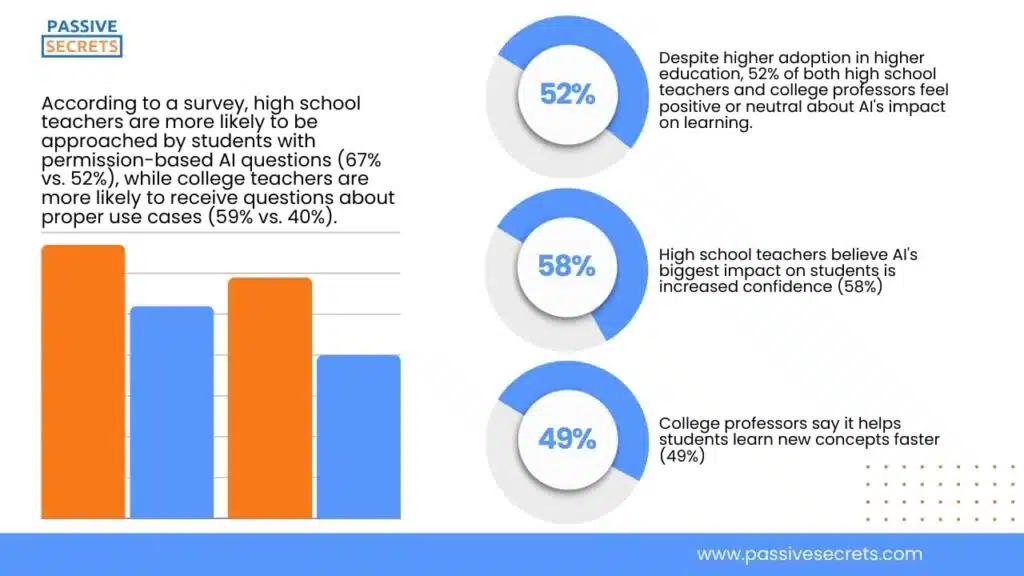
53. High school teachers believe AI’s biggest impact on students is increased confidence (58%), while college professors say it helps students learn new concepts faster (49%). (source)
54. Despite higher adoption in higher education, 52% of both high school teachers and college professors feel positive or neutral about AI’s impact on learning. (source)
Challenges and Limitations of AI in Education
55. Only 25% of teachers surveyed reported receiving training on AI chatbots, and about one-third (32%) cited the lack of training and professional development as key reasons for not using AI. (source)
56. Almost 20% of teachers interviewed stated that ChatGPT had a detrimental effect, a rise from 7% the year before. (source)
57. A quarter of K-12 teachers feel AI tools cause more harm than good, 32% see a balance of benefits and drawbacks, 6% believe they are more beneficial, and 35% are unsure. (source)
58. About 47% of elementary school teachers are unsure about the impact of AI tools in K-12 education. (source)
59. A 2023 survey revealed that 96% of K-12 teachers in the United States reported not having received any professional development or training on artificial intelligence (AI). (source)
60. In addition, 55% expressed concern about the impact of AI on education, while 49% felt it would make their jobs more difficult within the next three years. (source)
61. 60% of educators surveyed expressed concern that AI could negatively affect students’ independent thinking, writing, and research skills. (source)
62. 72% of educators cited the potential for increased plagiarism and cheating as their biggest concern regarding generative AI. (source)
63. Among surveyed educators who haven’t used AI in the classroom, 65% cited a lack of familiarity as the main reason, while 48% raised ethical concerns. (source)
64. In 2024, 69% of students and teachers said their school hadn’t established an AI code of conduct, down from 72% in 2023. The most trusted groups to create AI guidelines are schools and districts (65%), government (34%), and tech companies (31%). (source)
65. 66% of teachers report not having received any formal training on using AI in education. (source)
66. 76% of teachers and 65% of students agree that using AI for homework or exams constitutes cheating. (source)
67. A significant number of students find it acceptable to have their work written by ChatGPT, with more than 1 in 4 (28%) considering it acceptable to use AI to write paragraphs of their assignments. (source)
68. 93% of teachers and 79% of students believe that regulations should be established to control the use of text-generating AI in education. (source)
69. Most educators (85%) feel unprepared to manage the use of generative AI in their classrooms, with nearly a third (32%) stating they are completely unprepared. (source)
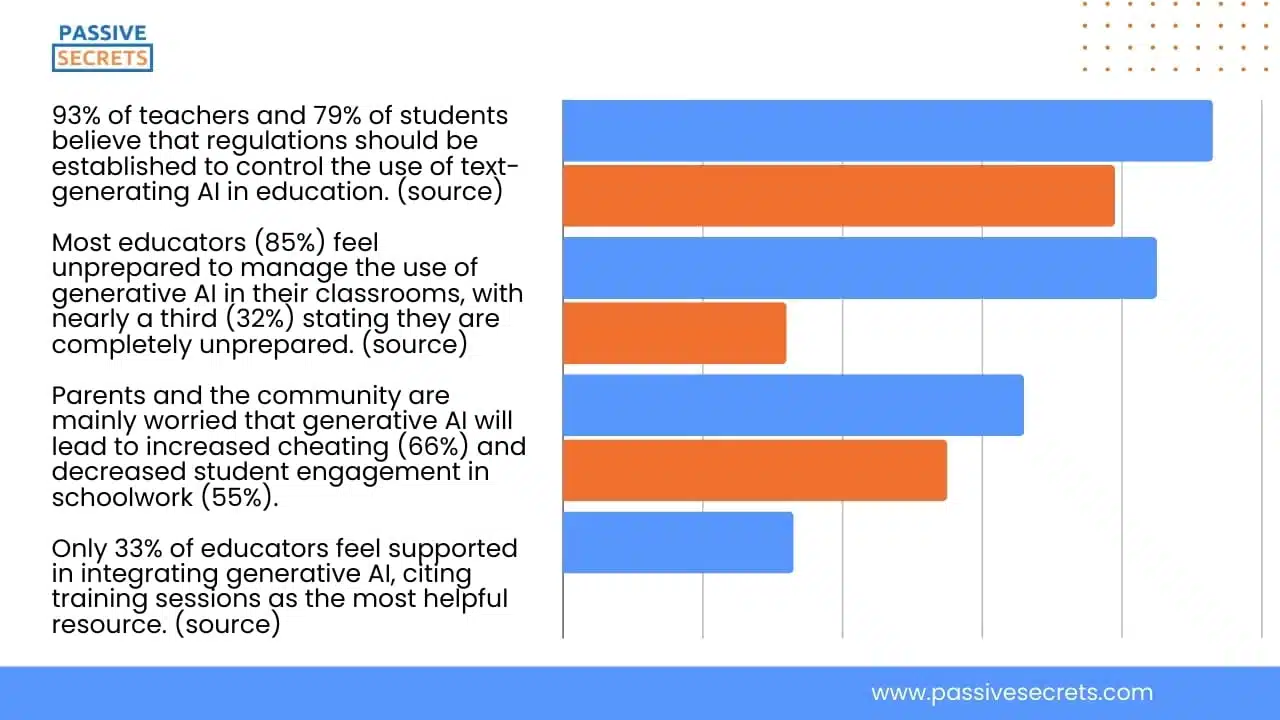
70. Only 33% of educators feel supported in integrating generative AI, citing training sessions as the most helpful resource. (source)
71. Parents and the community are mainly worried that generative AI will lead to increased cheating (66%) and decreased student engagement in schoolwork (55%). (source)
Future Outlook of AI in Education
72. Nearly two-thirds of both teachers and students are opposed to banning AI. (source)
73. 72% of students and 81% of teachers express concern about the impact of AI on the future of learning. (source)
AI in Education Trends 2025
1. Intelligent Tutoring
One of the key ways that AI has been found to impact the educational sector is tutoring. It has successfully brought modern techniques to solving students’ learning problems.
Through an accurate breakdown of complex topics and concepts, AI has gained massive acceptance with most students and educators alike but it doesn’t end there.
The use of AI has provided better interaction when it comes to learning materials. Through videos & quizzes, information could be explained more thoroughly.
It could also help students create the right study plan adjustments to their goals, preferences, and skills through modern generative tools and platforms.
2. Personalized Learning Experience
The rise of Generative AI has been seen to provide information on students’ strengths, weaknesses, struggles, performance, and even learning styles.
Through this information, students can be offered a helpful and personalized learning experience that aligns with their unique needs.
This trend guarantees the best learning option to different individuals, whether through video, audio, or audio-visual content.
This would not only help students make progress in their academic goals but also help them track their progress to identify what areas could be touched upon.
3. Inclusive Education
The use of AI in education promotes a high level of inclusivity to different students’ needs.
Through the use of AI, students with physical and learning disabilities are now being considered and given a fair chance at education.
Platforms that offer audio materials, visual aids, speech-to-text and text-to-speech advantages are now significantly gaining traction in the educational sector.
In 2024, AI would be used to recognize the emotions and problems of students, and proffer the right solutions to them.
4. Teaching with Virtual Avatars
AI-powered virtual avatars are set to transform college video lessons, providing an affordable and innovative solution for educational institutions.
These avatars can be created using a photo of a real person and can speak multiple languages, enabling personalized learning experiences for students worldwide.
This technology will make college education more accessible, flexible, and adaptable for students with diverse learning styles and languages.
FAQs
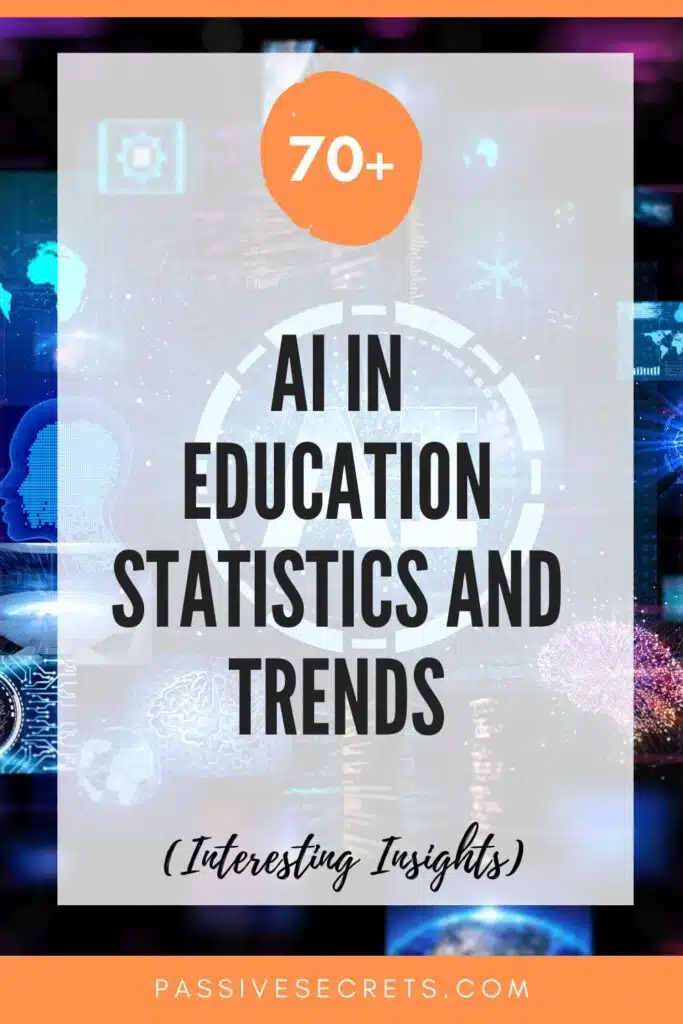
Other Related Statistics You Should Know:
- 101 Billionaire Statistics: Surprising Insights About The World’s Wealthiest
- 89 Business Loan Statistics Every Entrepreneur Should Know
- Women in Leadership Statistics: Insights into Global Gender Representation
- Soft Skills Statistics: Key Data on Demand, Training, and Impact
- 95+ Fascinating Gift Industry Statistics to Surprise and Delight
- Top Business Coaching Statistics & Trends Every Leader Should Know
- How Much Are People Saving? Key Personal Savings Statistics Explained
- 40+ Useful Procrastination Statistics To Help You
- 90 Amazing Millionaire Statistics & Facts You Dare Not Miss
- 50+ Latest Life Coaching Statistics And Huge Trends
- 30+ Useful Real Estate Photography Statistics and Trends You Need to Know
- Data-Driven Decision-Making Statistics: Trends, Benefits & Challenges
- 54 Incredible Goal-Setting Statistics To Help You
- 45+ Interesting Communication Skills Statistics & Huge Trends
- Body Language Statistics & Fun Facts To Boost Your Communication Skills
- 35 Interesting Public Speaking Fear Statistics & Fun Facts
- 25+ Most Interesting Emotional Intelligence Statistics & Fun Facts

